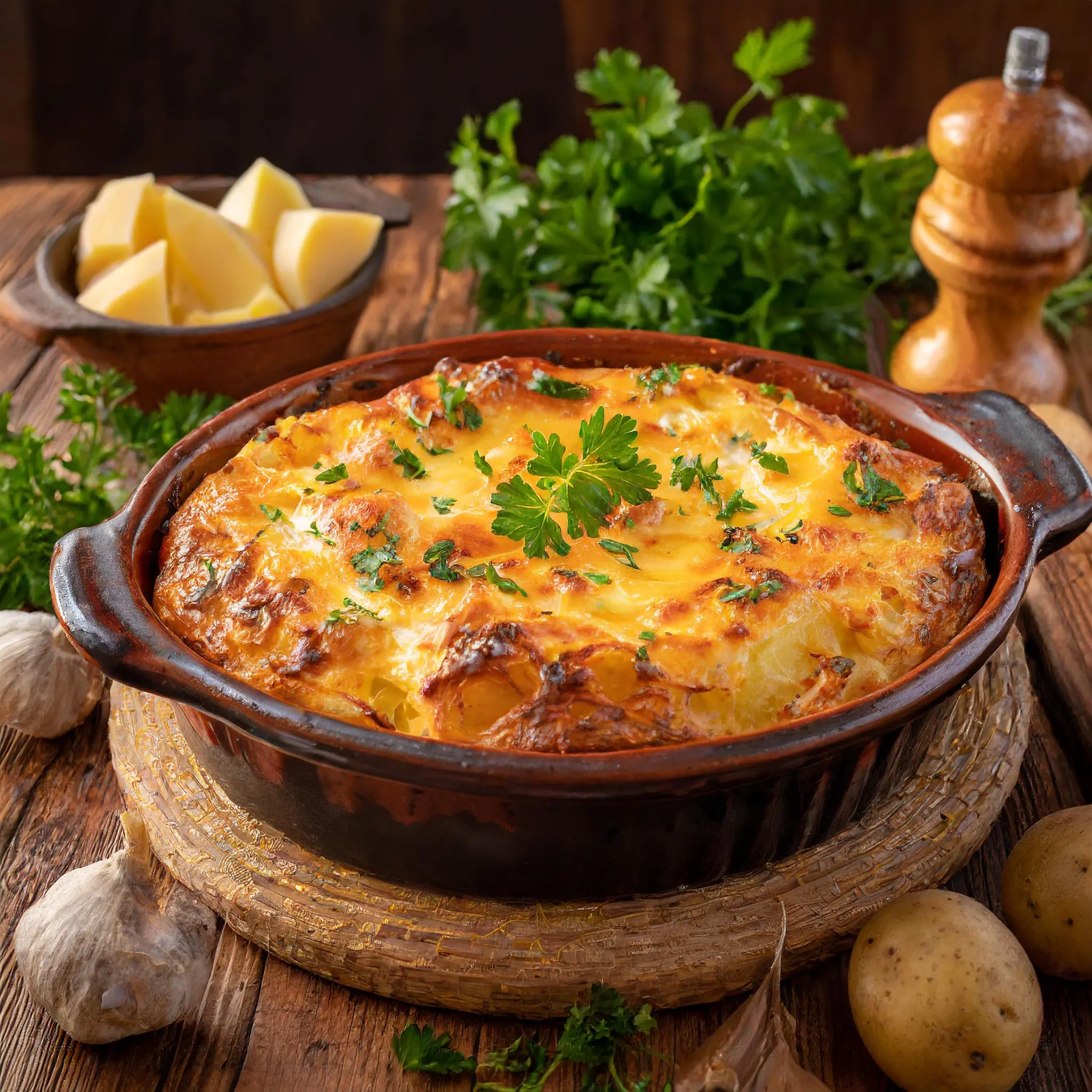When it comes to comfort food, few dishes can rival the warm, hearty appeal of a well made Potato Casserole. Indeed, this quintessential crowd pleaser combines layers of creamy, cheesy goodness with the irresistible heartiness of potatoes, making it a staple at family dinners, holiday gatherings, and potlucks alike. Whether you’re a seasoned chef or a kitchen novice, mastering the perfect Potato Casserole is a culinary milestone
that will delight both you and your loved ones.
Table of contents
Ingredients for Potato Casserole
Creating the perfect potato casserole begins with selecting the right component. Moreover, the beauty of this dish lies in its simplicity humble component come together to create a rich and flavorful experience. Here’s what you’ll need, along with some tips for choosing the best options.
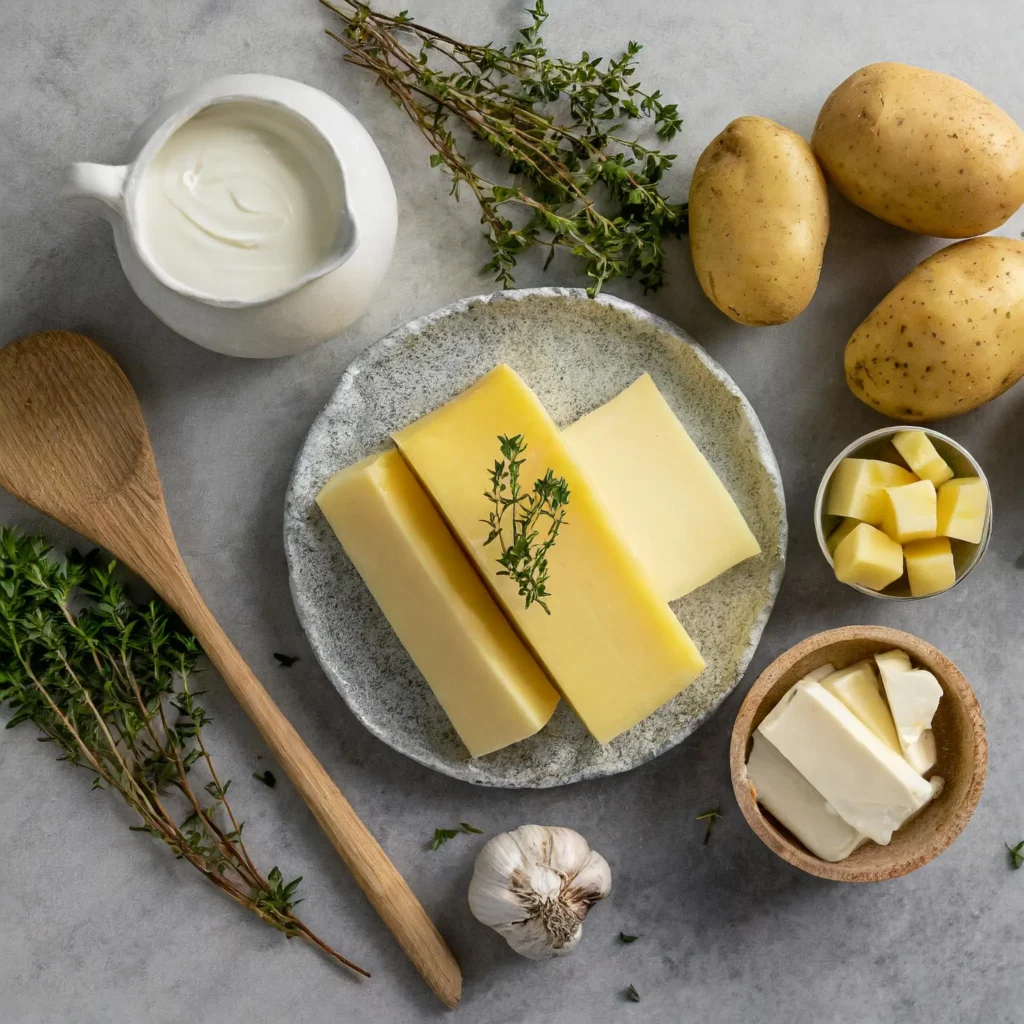
Core Ingredients
- Potatoes
Potatoes are, of course, the heart of this dish. However, the type of potato you choose will significantly impact the casserole’s texture and flavor.
- Russet Potatoes: Known for their high starch content, russet potatoes are ideal for creating a fluffy and light casserole. They absorb flavors well and develop a tender texture when baked.
- Yukon Gold Potatoes: These are a popular alternative due to their buttery flavor and creamy texture. They hold their shape better than russets, making them perfect for sliced or layered casseroles.
Tip: Use fresh, firm potatoes without sprouts or blemishes for the best results.
- Dairy
Dairy products add richness and creaminess to the casserole. For instance, milk provides a light, creamy base, while heavy cream offers a richer and more indulgent texture.
- Milk: Provides a light, creamy base and binds the component together.
- Heavy Cream: Offers a richer and more indulgent texture, perfect for special occasions.
- Sour Cream: Adds a tangy flavor and creaminess, complementing the richness of the potatoes.
Tip: For a lighter option, consider substituting milk with unsweetened almond milk or low-fat yogurt.
- Cheese
Cheese gives potato casserole its signature creamy and gooey appeal. For example, popular choices include:
- Cheddar Cheese: A sharp and tangy cheese that melts beautifully.
- Mozzarella Cheese: Adds a mild, stretchy texture to the casserole.
- Parmesan Cheese: Perfect for sprinkling on top to create a golden crust.
Feel free to experiment with other cheeses like Gruyère, Monterey Jack, or a combination for added complexity.
- Seasonings and Spices
Seasonings bring the dish to life and can be tailored to your taste.
- Salt and Pepper: The foundation of seasoning.
- Garlic Powder: Enhances the savory flavors.
- Nutmeg: A pinch of nutmeg pairs wonderfully with cream-based dishes.
- Herbs: Fresh or dried thyme, parsley, or rosemary can add a fragrant touch.
Optional Add-Ins
To elevate your casserole, consider adding these optional component:
- Bacon: Crispy bacon bits add a smoky and savory flavor.
- Onions: Sautéed onions bring sweetness and depth to the dish.
- Vegetables: Add a layer of diced broccoli, spinach, or mushrooms for a nutritious twist.
In summary, selecting high-quality, fresh component ensures the best flavors and textures for your casserole.
Choosing High-Quality Ingredients
- Use fresh, organic component when possible for the best flavor.
- Select high-quality cheese that melts easily and adds depth to the dish.
- If using pre-grated cheese, ensure it doesn’t contain anti-caking agents, as these can affect the texture.
Now that you’ve gathered your component, it’s time to move on to the tools and equipment you’ll need to prepare this dish.
Step-by-Step Guide to Preparing Potato Casserole
Preparing a potato casserole is an art that combines layering, seasoning, and baking to create a dish that’s rich, flavorful, and satisfying. As a result, this comprehensive step-by-step guide will help you craft a casserole that’s sure to impress.
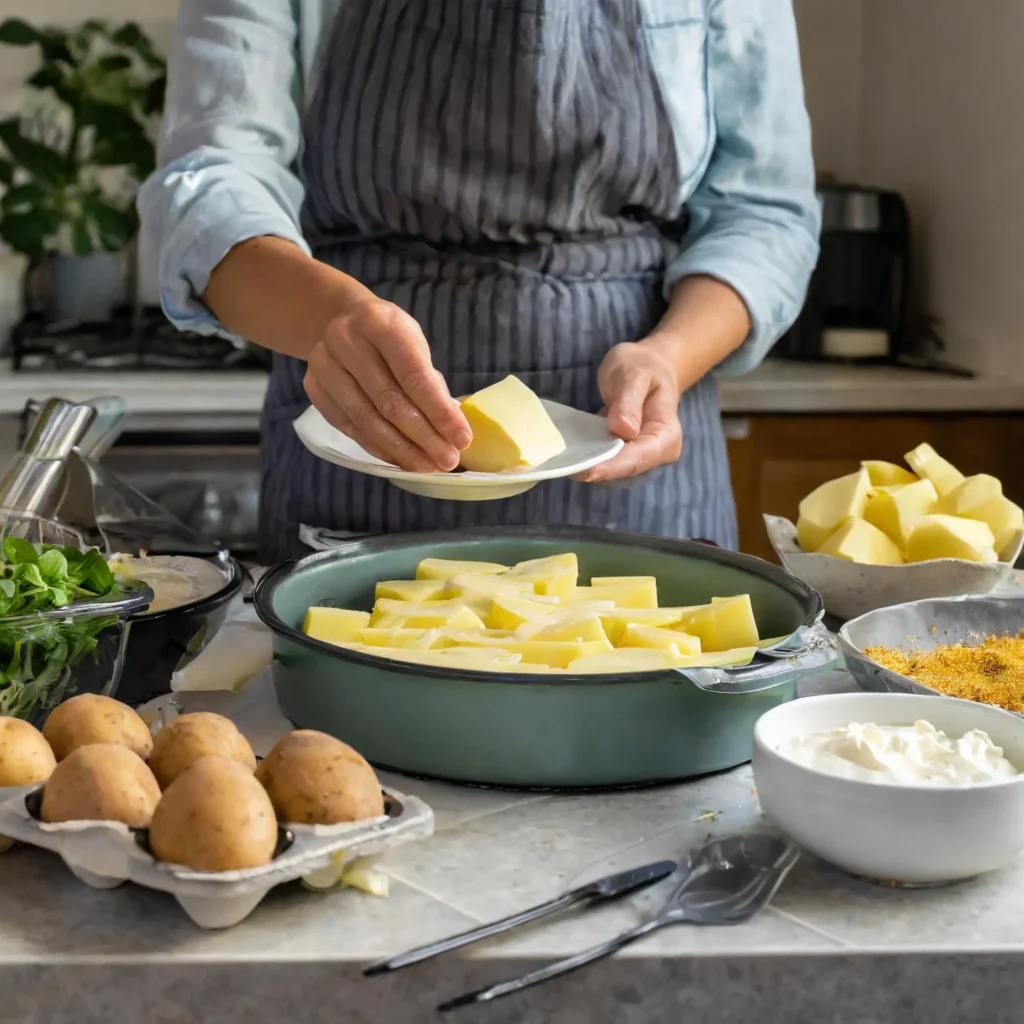
Step 1: Prepping the Potatoes
- Select and Wash the Potatoes
Choose fresh potatoes, such as russets or Yukon Golds, depending on your desired texture. Rinse them thoroughly under running water to remove dirt and debris. - Peel the Potatoes (Optional)
Use a vegetable peeler to remove the skin if you prefer a smoother texture. Alternatively, leave the skin on for a more rustic and earthy flavor. - Slice or Grate the Potatoes
For sliced casseroles, use a mandoline slicer to cut uniform slices. For shredded casseroles, grate the potatoes using a box grater or food processor.
Tip: Soak sliced potatoes in cold water for 10–15 minutes to remove excess starch. This prevents them from sticking together and ensures a fluffier casserole.
Step 2: Preparing the Base Mixture
1. Combine Dairy and Spices
- In a large mixing bowl, combine dairy with seasonings. For instance:
- 2 cups of milk or cream
- 1 teaspoon of salt
- 1/2 teaspoon of black pepper
Additionally, mix in garlic powder and nutmeg for added depth.
2. Add Cheese
- Stir in Cheese: Stir in 1–2 cups of shredded cheese to add extra creaminess to the mixture.Reserve Some Cheese: Save a portion of the cheese to sprinkle on top for a golden, bubbly crust after baking.
3. Incorporate Optional Ingredients
- Enhance the Flavor: Mix in cooked bacon bits, sautéed onions, or fresh herbs to boost the flavor profile.For a Custard-Like Texture: If desired, whisk 2 eggs into the mixture for a firmer, custard-like texture.
Step 3: Building the Casserole
1. Grease the Casserole Dish
- Prepare the Dish: Use butter or non-stick cooking spray to coat the bottom and sides of the casserole dish.
- Why It’s Important: This prevents sticking and makes cleanup much easier later.
2. Layer the Potatoes
- Arrange the First Layer: Place a single, even layer of potato slices (or grated potatoes) across the bottom of the dish.
- Overlap Slightly: Slightly overlap the slices to ensure complete coverage and even cooking.
3. Add the Base Mixture
- Pour the dairy mixture over the potatoes and sprinkle cheese on top. Continue layering until all component are used.
- Sprinkle a small handful of cheese over the mixture for extra creaminess.
4. Repeat the Layers
- Continue layering potatoes, base mixture, and cheese until you’ve used all the component. Finish with a generous layer of cheese on top.
Step 4: Adding the Topping
1. Choose a Topping
- Classic Cheese: Sprinkle an additional layer of shredded cheese for a gooey finish.
- Breadcrumbs: Combine breadcrumbs with melted butter and sprinkle over the top for a crispy crust.
- Herbs: Add a sprinkle of chopped parsley or thyme for a fragrant touch.
2. Apply the Topping
- Evenly distribute your chosen topping across the casserole. Ensure that it covers the entire surface for uniform texture and flavor.
Step 5: Let It Rest Before Baking
Allow the casserole to sit for 10–15 minutes before baking. This gives the potatoes a chance to absorb some of the liquid, resulting in a more cohesive dish.
Cooking the Potato Casserole
The baking process is where all the preparation comes together, transforming layers of potatoes, dairy, and cheese into a golden, bubbling masterpiece. Proper cooking techniques ensure the casserole is evenly baked, with a tender interior and a perfectly crispy top.
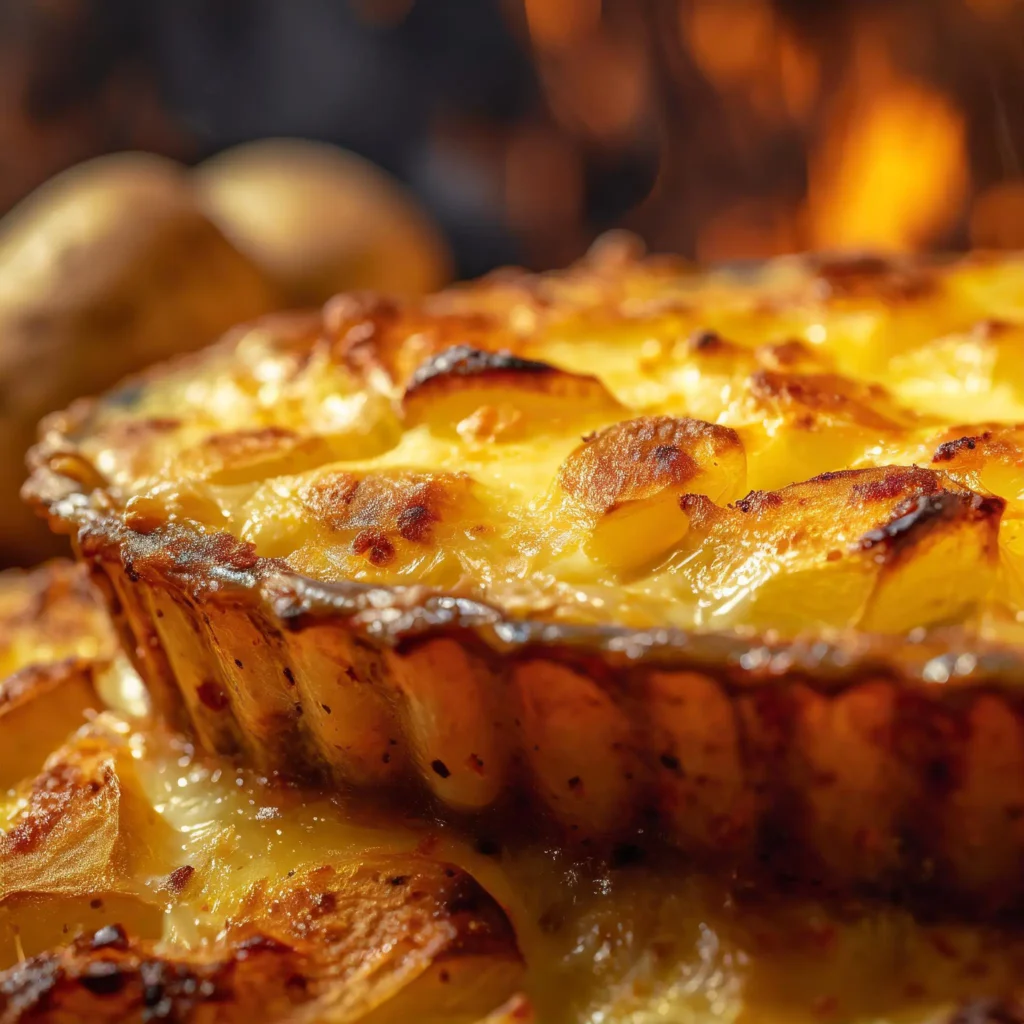
Step 1: Preheat the Oven
Finally, bake the assembled casserole to perfection:
- Preheat your oven to 375°F (190°C).
- Cover the casserole with foil and bake for 45–60 minutes.
- Uncover during the last 15 minutes for a golden crust.
After baking, allow the casserole to rest before serving.
Step 2: Bake the Casserole
1. Cover the Dish
- Use aluminum foil or a fitted lid to cover the casserole dish. This traps heat and moisture, ensuring the potatoes cook through evenly without drying out.
- Avoid letting the foil touch the cheese layer to prevent sticking.
2. Initial Baking Time
- Bake the covered casserole for 45–60 minutes, depending on the depth and size of your dish.
- Check for doneness by inserting a fork or knife into the center. The potatoes should be tender and easy to pierce.
Step 3: Uncover for a Golden Finish
- Remove the foil or lid for the final 15–20 minutes of baking.
- Sprinkle additional cheese, breadcrumbs, or herbs on top if desired.
- Continue baking until the top is golden brown and bubbly.
Tip: For an extra-crispy crust, switch to the broil setting for the last 2–3 minutes, keeping a close eye to prevent burning.
Step 4: Check for Doneness
- Test the potatoes in the center of the casserole. If they’re soft and cooked through, the casserole is ready.
- The cheese topping should be melted and slightly browned, adding a delicious contrast of textures.
Step 5: Let It Rest
- Remove the casserole from the oven and let it rest for 10–15 minutes before serving.
- Resting allows the dish to set, making it easier to slice and serve without falling apart.
Troubleshooting During Baking
1. Uneven Cooking
If parts of the casserole are cooking faster than others:
- Rotate the dish halfway through baking to ensure even heat distribution.
- Check that your potato slices are uniformly thick, as uneven slices can cause uneven cooking.
2. Excess Moisture
If your casserole appears too watery:
- Reduce the dairy in the recipe next time, or allow it to bake uncovered for longer to evaporate excess liquid.
3. Burnt Topping
If the topping is browning too quickly:
- Cover the dish loosely with foil until the potatoes are fully cooked, then remove it for the final browning stage.
Adjusting Cooking Times for Different Casserole Sizes
- Smaller Casseroles: For smaller dishes, reduce the cooking time to 30–40 minutes and check frequently to avoid overcooking.
- Larger Casseroles: Deep dishes may require up to 75–90 minutes. Test for doneness before removing from the oven.
Serving Suggestions and Pairings
Potato casserole is a versatile dish that can stand alone as a comforting main course or shine as a hearty side. To elevate your dining experience, pair your casserole with complementary dishes and serve it in the most appealing way possible. For example, adding roasted vegetables or a fresh salad can create a balanced meal.
Step 1: Serving the Potato Casserole
1. Portion Sizes
- As a Side Dish: Serve smaller portions (about 1 cup per person) alongside a protein or vegetable-based main course.
- As a Main Dish: For heartier servings, offer 1.5–2 cups per person, garnished with fresh herbs or a dollop of sour cream.
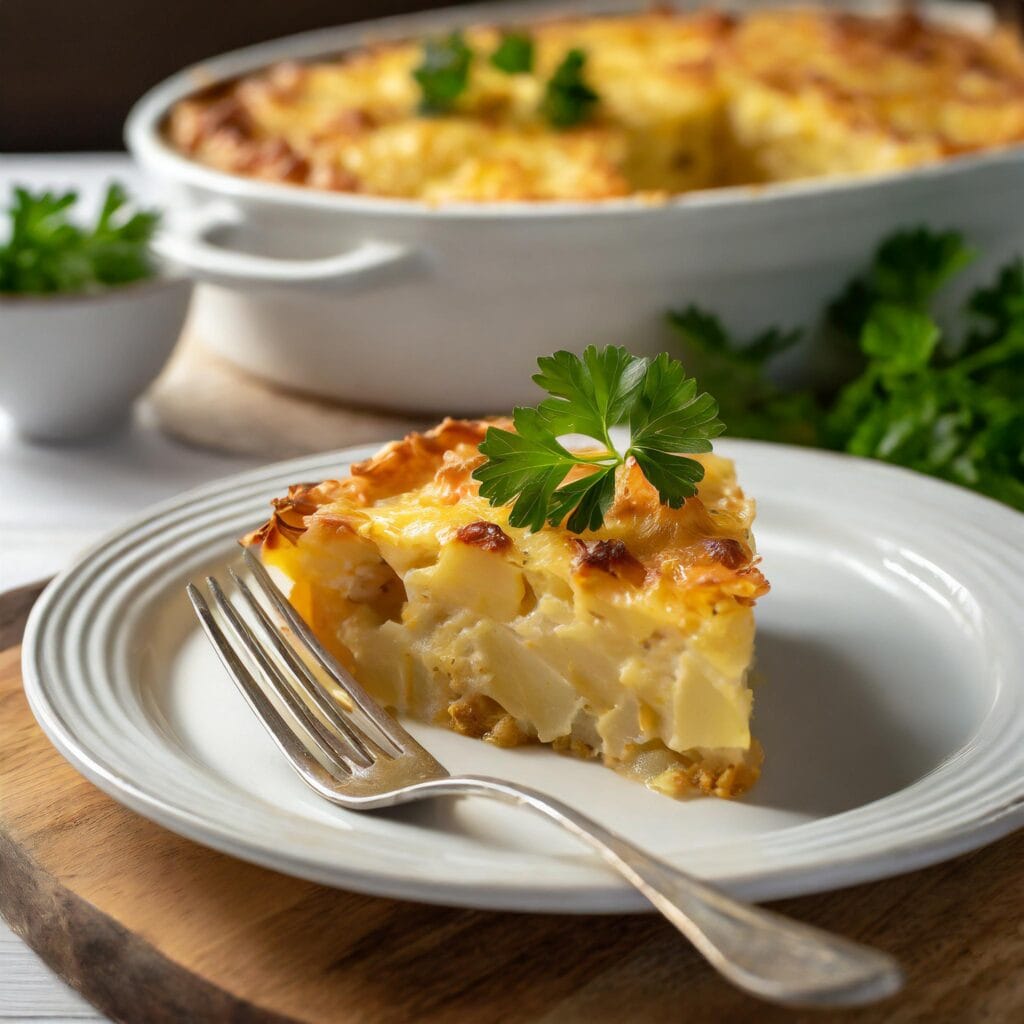
2. Presentation Tips
- Cut and Serve: Begin by using a spatula to slice the casserole into neat squares or wedges. This will ensure a clean and professional presentation.
- Garnish: Next, sprinkle fresh parsley, chopped chives, or drizzle a bit of melted butter over each serving. This adds both color and visual appeal, making the dish more inviting.
- Serve Family-Style: Finally, present the casserole directly in its baking dish. This creates a cozy, rustic feel that’s ideal for gatherings and enhances the dining experience.
Step 2: Pairing with Proteins
Potato casseroles pair beautifully with various proteins, as they perfectly complement the creamy, rich flavors of the dish. To enhance your meal, here are some excellent options to consider:
1. Roast or Grilled Meats
- Roast Chicken: Lightly seasoned roast chicken not only enhances the casserole’s creamy texture but also provides a balanced and flavorful pairing.
- Beef or Pork Roast: Hearty and savory meats create a satisfying contrast to the soft and cheesy potatoes, making the meal more indulgent.
- Grilled Sausages: The smoky, robust flavor of grilled sausages pairs wonderfully with the richness of a potato casserole, adding a bold and complementary taste.
2. Seafood Options
- Salmon: A baked or grilled salmon fillet offers a light and healthy pairing that doesn’t overshadow the creamy casserole.Shrimp Skewers: Juicy, flavorful shrimp add a vibrant punch to the meal, making it both delicious and well-rounded.White Fish: Mild, flaky fish like cod or haddock provides a subtle complement to the casserole without overpowering it.
3. Vegetarian Proteins
- Lentil Loaf: This hearty plant-based option works wonderfully with creamy casseroles, offering a satisfying and nutritious alternative.Tofu Steaks: Marinated and grilled tofu adds both texture and protein, making it a delightful vegetarian choice.
Step 3: Pairing with Vegetables
Adding vegetables to your meal brings balance and freshness, effectively contrasting with the richness of the casserole. For a well-rounded dish, here are some vegetable pairings to consider:
1. Green Vegetables
- Steamed Broccoli or Asparagus: Lightly steamed veggies not only add brightness but also balance the creamy casserole.
- Sautéed Spinach or Kale: Cooked with garlic and lemon juice, these greens provide a flavorful and healthy side.
- Green Bean Almondine: Toasted almonds with green beans add a satisfying crunch and enhance the overall texture of the meal.
2. Roasted Vegetables
- Carrots and Parsnips: Their natural sweetness pairs beautifully with the creamy casserole, offering a delightful contrast.
- Brussels Sprouts: Roasting with balsamic vinegar adds a tangy contrast that complements the dish.
3. Fresh Salads
- Caesar Salad: Crisp romaine lettuce with a tangy dressing adds a refreshing and crunchy element.
- Mixed Greens: Tossed with a light vinaigrette, mixed greens help balance the richness of the casserole.
Step 4: Beverages to Complement
The right drink can significantly enhance the flavors of your potato casserole and complete the meal. Consider these options to elevate your dining experience:
1. Wines
- White Wine: A buttery Chardonnay or crisp Sauvignon Blanc pairs wonderfully with creamy textures, bringing out the richness of the dish.
- Red Wine: Light reds like Pinot Noir offer a fruity contrast that doesn’t overpower the casserole, making them a perfect choice.
2. Non-Alcoholic Options
- Sparkling Water: Add a slice of lemon or lime for a refreshing, palate-cleansing drink.
- Iced Tea: Whether sweetened or unsweetened, it complements the comforting feel of the casserole.
Step 5: Storing and Reheating Leftovers
Potato casseroles are perfect for meal prep because they store and reheat well. Follow these tips for best results:
1. Storing
- In the Fridge: Store leftovers in an airtight container for up to 3–5 days.
- In the Freezer: For long-term storage, portion the casserole and wrap tightly in plastic wrap and aluminum foil to avoid freezer burn. Freeze for up to 3 months.
2. Reheating
- Oven: Preheat to 350°F (175°C), cover the casserole with foil, and bake for 20–25 minutes or until heated through.
- Microwave: Heat individual portions on medium power to prevent uneven heating.
- Stovetop: Warm small portions in a non-stick skillet over low heat, stirring occasionally.
Variations of Potato Casserole
Potato casserole is one of the most versatile dishes, adaptable to fit different tastes, dietary needs, and occasions. Whether you’re aiming for a classic rendition, a modern twist, or a health conscious option, there’s a variation for everyone. Below are some creative and delicious ideas to inspire your next casserole creation.
1. Traditional Potato Casserole
Ingredients
- To start, layer thinly sliced russet potatoes.
- Then, create a creamy mixture using milk, butter, and cheese.
- Finally, top it with a golden layer of cheddar cheese.
Why It Works
This timeless recipe highlights the simplicity of combining potatoes and cheese. Indeed, the tender potatoes and rich, melted cheese provide comfort in every bite. Because of this, it is perfect for holiday dinners or as a flavorful side dish for roast meats.
2. Loaded Baked Potato Casserole
What’s Inside
- This casserole captures all the flavors of a loaded baked potato. For instance, it includes sour cream, cheddar cheese, crispy bacon, and chopped green onions.
- Additionally, Yukon Gold potatoes add a buttery and creamy texture that enhances the dish.
Why It’s a Hit
It’s a crowd-pleaser because it combines bold flavors with a satisfying mix of creamy, cheesy, and crunchy textures. As a result, this dish is ideal for family meals or potluck gatherings.old flavors and a satisfying combination of creamy, cheesy, and crunchy textures.
3. Vegan Potato Casserole
Dairy-Free Ingredients
- Instead of dairy, you can use cashew cream or coconut milk as a creamy alternative.
- Additionally, nutritional yeast provides a cheesy flavor without any dairy.
- To make it even more nutritious, consider adding vegetables like spinach, mushrooms, or zucchini.
Tips for Success
Then, use a plant-based butter alternative to achieve a creamy consistency.
Ultimately, this version is ideal for those who prefer plant-based options while still enjoying a satisfying meal.
First, layer the potatoes with plenty of seasoning to maximize their flavor.
4. Low-Carb Potato Casserole
Substitute Potatoes
- To make it low-carb, replace traditional potatoes with zucchini or cauliflower.
- Next, mix them with heavy cream and cheese to create a rich and indulgent base.
Why It’s Perfect for Low-Carb Diets
This casserole is a fantastic way to enjoy a creamy dish while staying within your dietary goals. Therefore, it’s a guilt-free alternative that doesn’t compromise on flavor.or keto diets who still crave the indulgence of a casserole without the extra carbs.
5. Holiday-Inspired Potato Casserole
Festive Additions
- Incorporate seasonal component like cranberries, roasted pecans, or caramelized onions.
- Sweeten with a drizzle of honey or maple syrup for a Thanksgiving or Christmas twist.
Perfect Pairings
Serve with turkey, ham, or a nut roast for a holiday-worthy meal.
FAQs About Potato Casserole
Potato casserole is a beloved dish, but it often raises questions for cooks trying to perfect it. Here are some frequently asked questions and expert answers to help you make the best potato casserole possible.
1. How Do I Make My Casserole Crispier on Top?
Answer:
To achieve a crispy, golden topping:
- Add Toppings: Use breadcrumbs mixed with melted butter, Parmesan cheese, or crushed crackers for extra crunch.
- Uncover for Final Baking: Bake the casserole uncovered during the last 15–20 minutes to allow the top to brown.
- Broil Briefly: Switch to the broil setting for the final 2–3 minutes, keeping a close eye to prevent burning.
2. Can I Prepare the Casserole Ahead of Time?
Answer:
Yes, potato casserole can be prepared in advance:
- Assemble the casserole up to a day ahead and cover it tightly with plastic wrap or foil. Store it in the refrigerator.
- When ready to bake, bring the dish to room temperature for 20–30 minutes before placing it in the oven.
- For freezing, assemble the casserole without baking, wrap it securely, and freeze for up to 3 months.
3. How Long Can I Store Potato Casserole in the Fridge?
Answer:
- Store leftover potato casserole in an airtight container in the refrigerator for 3–5 days.
- To maintain freshness, reheat only the portions you plan to eat, as repeated reheating can degrade the texture and flavor.
4. What Are Some Good Substitutes for Heavy Cream?
Answer:
If you prefer a lighter option or don’t have heavy cream on hand, try these substitutes:
- Whole Milk: Combine with a tablespoon of butter for a similar richness.
- Greek Yogurt: Adds creaminess and a slight tang.
- Coconut Milk: A non-dairy option with a rich consistency, though it adds a hint of coconut flavor.
- Cashew Cream: Perfect for vegan versions, offering a smooth, creamy texture.
5. Can I Freeze Potato Casserole?
Answer:
Yes, potato casserole freezes well if done correctly:
- Before Baking: Assemble the casserole, wrap it tightly in plastic wrap and aluminum foil, and freeze for up to 3 months.
- After Baking: Allow the casserole to cool completely, then portion it into airtight containers or freezer-safe bags.
- Reheating from Frozen: Bake at 350°F (175°C) for about 45 minutes, covered with foil, or until heated through.
Tip: Avoid freezing casseroles with high moisture content toppings, as they may become soggy when thawed.
Conclusion
To summarize, potato casserole is a timeless dish that combines comfort and indulgence. Whether it’s for a holiday feast or a family dinner, mastering this dish will make you the star of any gathering, see the following article cooker potato salad the ultimate recipe guide

